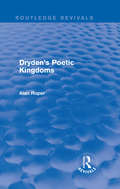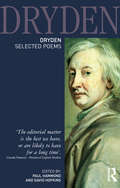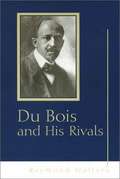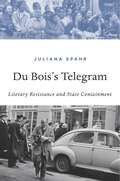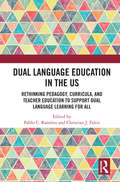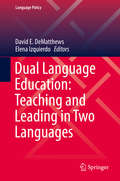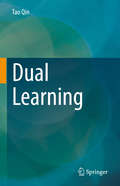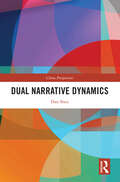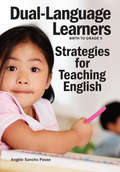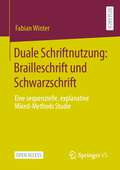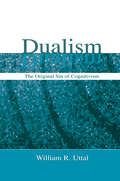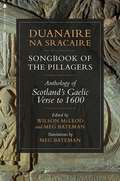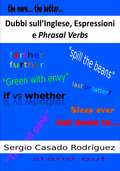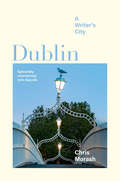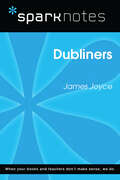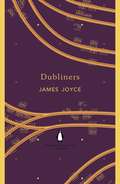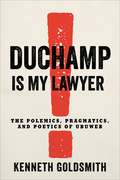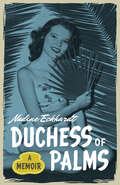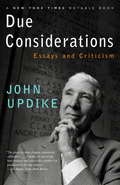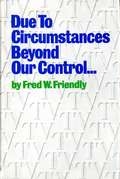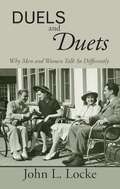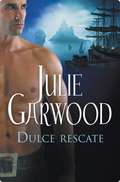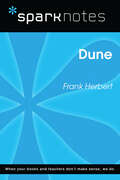- Table View
- List View
Dryden's Poetic Kingdoms (Routledge Revivals)
by Alan RoperDr. Roper describes the mode of many of Dryden’s original poems by redefining the royalism that provides the matter of some works and the metaphoric vocabulary of others. Dryden’s royalism is seen both as an identifiable political attitude and a way of apprehending public life that again and again relates superficially non-political matters to the standards and assumptions of politics in order to determine their public significance. Dryden’s Poetic Kingdoms, first published in 1965, principally through readings of ten poems, comes to the conclusion that Dryden’s poems are most successful when they work to create a meaningful analogy between such topics as literature and politics or between the constitution of England and the constitution of Rome, the Garden of Eden, or Israel under David.
Dryden: Selected Poems (Longman Annotated English Poets)
by PAUL HAMMOND; DAVID HOPKINSDryden: Selected Poems is drawn from Paul Hammond and David Hopkins's remarkable five-volume The Poems of John Dryden, and includes a generous selection of his most important work. The great satires, MacFlecknoe and Absalom and Achitophel, are included in full, as are his religious poemsReligio Laici and The Hind and the Panther, along with a number of Dryden's translations from Horace, Ovid, Homer, and Chaucer. Each poem is accompanied by a headnote, which gives details of composition, publication, and reception. The first-rate annotations provide information on matters of interpretation and give details of allusions that might prove baffling to contemporary readers. Some 300 years after his death, Dryden: Selected Poems will enable new generations of readers to discover the poet of whom Eliot wrote: 'we cannot fully enjoy or rightly estimate a hundred years of English poetry unless we fully enjoy Dryden'.
Du Bois and his Rivals
by Raymond WoltersAlthough focusing primarily on W. E. B. Du Bois, this book gives biagraphical information and criticisms of a few Civil Rights leaders, including Booker T. Washington and Marcus Garvey. It describes the similarities and differences between these men's views.
Du Bois’s Telegram: Literary Resistance and State Containment
by Juliana SpahrTaking her cue from W. E. B. Du Bois, Juliana Spahr explores how state interests have shaped U.S. literature. What is the relationship between literature and politics? Can writing be revolutionary? Can art be autonomous or is escape from nations and nationalisms impossible? As her sobering study affirms, aesthetic resistance is easily domesticated.
Dual Diaspora: Post-Soviet Culture in Search of Israeli Identity (McGill-Queen’s Azrieli Institute of Israel Studies Series)
by Alex MoshkinSince the collapse of the Soviet Union nearly one million Russian-speaking Jews have settled in Israel, reshaping its cultural, social, and political fabric. This influx has sparked a complex dialogue about the intersection of post-Soviet and Jewish identities in the Israeli context.Dual Diaspora offers a groundbreaking exploration of the cultural contributions of Russian-speaking immigrants to Israel over the past thirty years. Through the lenses of literature, cinema, and visual art, Alex Moshkin investigates how immigrants reconcile their Soviet past with their Israeli present, and what role the Russian language – central to the identity of Soviet Jews in the second half of the twentieth century – plays today. Highlighting works in both Russian and Hebrew, Moshkin describes how authors, artists, and filmmakers navigate their dual identities and engage with Jewish history, religious life, and cosmopolitan ideals while confronting the traumas of displacement and immigration.Expanding the study of contemporary Israeli life beyond its Hebrew-centric narratives, Dual Diaspora sheds light on a vibrant and overlooked cultural scene. It not only deepens our understanding of Russian-speaking Jews in Israel but also enriches a broader conversation about hybrid identities in an increasingly globalized world.
Dual Language Education in the US: Rethinking Pedagogy, Curricula, and Teacher Education to Support Dual Language Learning for All (Routledge Research in Language Education)
by Christian J. Faltis Pablo C. RamírezOriginally published as a special issue of the journal Theory into Practice, this text examines innovative practices and research relating to Dual Language Education (DLE) in the US. Offering a variety of perspectives, contributors consider how dual language learning can benefit English-speaking and partner-language students across K-12, and explore how multilingualism can be harnessed for wider academic success. By investigating the ways in which schools and teachers have ensured provision of an effective DLE curriculum, chapters identify pedagogies and learning environments which support dual language learning, and consider how policy, curricula, and teacher education can be designed to promote social justice and diversity through broader access to dual programs. This book will be of interest to graduate and post graduate students, researchers, academics, professionals and policy makers in the field of multicultural education, international & comparative education, bilingualism studies, education policy and pedagogy.
Dual Language Education: Teaching and Leading in Two Languages (Language Policy #18)
by Elena Izquierdo David E. DeMatthewsThis book provides a comprehensive and interdisciplinary examination of dual language education for Latina/o English language learners (ELLs) in the United States, with a particular focus on the state of Texas and the U.S.-Mexico border. The book is broken into three parts. Part I examines how Latina/o ELLs have been historically underserved in public schools and how this has contributed to numerous educational inequities. Part II examines bilingualism, biliteracy, and dual language education as an effective model for addressing the inequities identified in Part I. Part III examines research on dual language education in a large urban school district, a high-performing elementary school that serves a high proportion of ELLs along the Texas-Mexico border, and best practices for principals and teachers.This volume explores the potential and realities of dual language education from a historical and social justice lens. Most importantly, the book shows how successful programs and schools need to address and align many related aspects in order to best serve emergent bilingual Latino/as: from preparing teachers and administrators, to understanding assessment and the impacts of financial inequities on bilingual learners. Peter Sayer, The Ohio State University, USA
Dual Learning
by Tao QinMany AI (and machine learning) tasks present in dual forms, e.g., English-to-Chinese translation vs. Chinese-to-English translation, speech recognition vs. speech synthesis,question answering vs. question generation, and image classification vs. image generation. Dual learning is a new learning framework that leverages the primal-dual structure of AI tasks to obtain effective feedback or regularization signals in order to enhance the learning/inference process. Since it was first introduced four years ago, the concept has attracted considerable attention in multiple fields, and been proven effective in numerous applications, such as machine translation, image-to-image translation, speech synthesis and recognition, (visual) question answering and generation, image captioning and generation, and code summarization and generation. Offering a systematic and comprehensive overview of dual learning, this book enables interested researchers (both established and newcomers) and practitioners to gain a better understanding of the state of the art in the field. It also provides suggestions for further reading and tools to help readers advance the area. The book is divided into five parts. The first part gives a brief introduction to machine learning and deep learning. The second part introduces the algorithms based on the dual reconstruction principle using machine translation, image translation, speech processing and other NLP/CV tasks as the demo applications. It covers algorithms, such as dual semi-supervised learning, dual unsupervised learning and multi-agent dual learning. In the context of image translation, it introduces algorithms including CycleGAN, DualGAN, DiscoGAN cdGAN and more recent techniques/applications. The third part presents various work based on the probability principle, including dual supervised learning and dual inference based on the joint-probability principle and dual semi-supervised learning based on the marginal-probability principle. The fourth part reviews various theoretical studies on dual learning and discusses its connections to other learning paradigms. The fifth part provides a summary and suggests future research directions.
Dual Narrative Dynamics (China Perspectives)
by Dan ShenCombining narratological and stylistic methods, this book theorizes dual narrative dynamics comprised of plot development and covert progression, and demonstrates the consequences for the interpretation of literary works.In narratives with such dynamics, writers work simultaneously with overt and covert trajectories of signification, establishing a range of relationships between them. The two parallel narrative movements may complement, contradict or even subvert each other, and these relationships significantly influence readers’ understanding not just of events but also of characters, themes, and aesthetic values. The book provides a systematic theoretical account of such previously neglected dual narrative dynamics, substantiated and enriched by the textual analysis of works by Ambrose Bierce, Kate Chopin, Franz Kafka, and Katherine Mansfield. The study explores the many ways that these authors have used dual dynamics to increase the power of their narratives. In addition, the book identifies the challenges such dual dynamics present not only for narratology but also for stylistics and translation studies, and it develops sound and provocative proposals for meeting those challenges.In taking an interdisciplinary approach, this book will appeal to scholars and students in the fields of narrative and literary theory, literary criticism, literary stylistics, and translation studies.
Dual-Language Learners
by Angèle Sancho PasseGrowing research shows that many children from immigrant and refugee families are not doing well in school, due in part to linguistic and cultural disadvantages. Teaching dual-language learners requires cultural sensitivity, an understanding of language acquisition, and intentional teaching strategies. Combining research and techniques, this resource helps early childhood educators support dual-language learners as they develop the skills necessary for school readiness and success.Angèle Sancho Passe, an early childhood education consultant and writer, is trilingual and has worked with many programs serving dual-language learners. She is the author of Is Everybody Ready for Kindergarten?
Duale Schriftnutzung: Eine sequenzielle, explanative Mixed-Methods Studie
by Fabian WinterIn diesem Open-Access-Buch werden die schriftsprachlichen Kompetenzen von Schülerinnen und Schülern mit dualer Schriftnutzung untersucht. Von einem dualen Schriftspracherwerb spricht man, wenn Kinder oder Jugendliche mit Sehbeeinträchtigung neben der Schwarzschrift auch die Brailleschrift erlernen. Vom Erwerb eines zusätzlichen Schriftmediums profitieren insbesondere Lernende mit fortschreitenden oder schwerwiegenden Augenerkrankungen. Wie wirkt sich ein dualer Schriftspracherwerb auf die Leseflüssigkeit, die Rechtschreibung bzw. das Lese- und Hörverstehen aus? Wie können Kinder und Jugendliche mit dualer Schriftnutzung gefördert werden? Um diese Fragen zu beantworten, werden die Ergebnisse aus einer Kompetenzerhebung sowie mehreren Fallstudien herangezogen und mit dem aktuellen Kenntnis- und Forschungsstand zur dualen Schriftnutzung verknüpft. Dazu werden praktische und anschauliche Beispiele geliefert, wie der Unterricht von Kindern und Jugendlichen mit dualer Schriftnutzung gelingen kann.
Dualism: The Original Sin of Cognitivism
by William R. UttalDirected to scholars and senior-level graduate students, this book is an iconoclastic survey of the history of dualism and its impact on contemporary cognitive psychology. It argues that much of modern cognitive or mentalist psychology is built upon a cryptodualism--the idea that the mind and brain can be thought of as independent entities. This dualism pervades so much of society that it covertly influences many aspects of modern science, particularly psychology. To support the argument, the history of dualism is extended over 100,000 years--from the Paleolithic times until modern philosophical and psychological thinking. The questions regarding this topic that are answered in the book are: 1) Does dualism influence the scientific theories of psychology? 2) If so, should dualism be put aside in the search for a more objective analysis of human mentation?
Duanaire Na Sracaire: Anthology of Medieval Gaelic Poetry
by Wilson McLeod and Meg BatemanThe definitive Gaelic-English anthology of medieval Scottish verse: an annotated treasure trove of literary history spanning a millennium. Duanaire na Sracaire—or Songbook of the Pillagers—is the first anthology to bring together Scotland&’s Gaelic poetry from c.600-1600 AD, a time when Scotland shared its rich culture with Ireland. It includes a huge range of diverse poetry: prayers and hymns of Iona, Fenian lays, praise poems and satires, courtly songs and lewd rants, songs of battle and death, incantations and love poems. All poems appear with facing-page translations which capture the spirit and beauty of the originals and are accompanied by detailed notes. A comprehensive introduction sets the context and analyses the role and functions of poetry in Gaelic society. This collection will appeal to poetry lovers, Gaelic speakers and those keen to explore a vital part of Scotland&’s literary heritage.
Dubbi sull'Inglese, Espressioni e Phrasal Verbs
by Sergio Casado Rodríguez Flaminia MiragliaQuesto libro è pensato per studenti di inglese di livello intermedio che desiderano ampliare il loro vocabolario apprendendo nuovi phrasal verbs e nuove espressioni, e che vogliono risolvere alcuni dei dubbi più comuni.
Dublin: A Writer's City (Imagining Cities)
by Christopher MorashThe words of its writers are part of the texture of Dublin, an invisible counterpart to the bricks and pavement we see around us. Beyond the ever-present footsteps of James Joyce's characters, Leopold Bloom or Stephen Dedalus, around the city centre, an ordinary-looking residential street overlooking Dublin Bay, for instance, presents the house where Nobel Laureate Seamus Heaney lived for many years; a few blocks away is the house where another Nobel Laureate, W. B. Yeats, was born. Just down the coast is the pier linked to yet another, Samuel Beckett, from which we can see the Martello Tower that is the setting for the opening chapter of Ulysses. But these are only a few. Step-by-step, Dublin: A Writer's City unfolds a book-lover's map of this unique city, inviting us to experience what it means to live in a great city of literature. The book is heavily illustrated, and features custom maps.
Dubliners (SparkNotes Literature Guide Series)
by SparkNotesDubliners (SparkNotes Literature Guide) by James Joyce Making the reading experience fun! Created by Harvard students for students everywhere, SparkNotes is a new breed of study guide: smarter, better, faster.Geared to what today's students need to know, SparkNotes provides:chapter-by-chapter analysis explanations of key themes, motifs, and symbols a review quiz and essay topics Lively and accessible, these guides are perfect for late-night studying and writing papers.
Dubliners (The Penguin English Library)
by James JoyceWith an essay by J. I. M. Stewart.'Every night as I gazed up at the window I said softly to myself the word paralysis. It had always sounded strangely in my ears ... But now it sounded to me like the name of some maleficent and sinful being. It filled me with fear, and yet I longed to be nearer to it and to look upon its deadly work'From a child grappling with the death of a fallen priest, to a young woman's dilemma over whether to elope to Argentina with her lover, to the dance party at which a man discovers just how little he really knows about his wife, these fifteen stories bring the gritty realism of existence in Joyce's native Dublin to life. With Dubliners, James Joyce reinvented the art of fiction, using a scrupulous, deadpan realism to convey truths that were at once blasphemous and sacramental.The Penguin English Library - 100 editions of the best fiction in English, from the eighteenth century and the very first novels to the beginning of the First World War.
Duchamp Is My Lawyer: The Polemics, Pragmatics, and Poetics of UbuWeb
by Kenneth GoldsmithIn 1996, during the relatively early days of the web, Kenneth Goldsmith created UbuWeb to post hard-to-find works of concrete poetry. What started out as a site to share works from a relatively obscure literary movement grew into an essential archive of twentieth- and twenty-first-century avant-garde and experimental literature, film, and music. Visitors around the world now have access to both obscure and canonical works, from artists such as Kara Walker, Yoko Ono, Pauline Oliveros, Samuel Beckett, Marcel Duchamp, Cecil Taylor, Glenn Ligon, William Burroughs, and Jean-Luc Godard.In Duchamp Is My Lawyer, Goldsmith tells the history of UbuWeb, explaining the motivations behind its creation and how artistic works are archived, consumed, and distributed online. Based on his own experiences and interviews with a variety of experts, Goldsmith describes how the site navigates issues of copyright and the ways that UbuWeb challenges familiar configurations and histories of the avant-garde. The book also portrays the growth of other “shadow libraries” and includes a section on the artists whose works reflect the aims, aesthetics, and ethos of UbuWeb. Goldsmith concludes by contrasting UbuWeb’s commitment to the free-culture movement and giving access to a wide range of artistic works with today’s gatekeepers of algorithmic culture, such as Netflix, Amazon, and Spotify.
Duchess of Palms: A Memoir
by Nadine EckhardtChild of the Great Depression, teenage "Duchess of Palms" beauty queen, wife of an acclaimed novelist and later of a brilliant U. S. congressman, and ultimately a successful single working woman and mother, Nadine Eckhardt has lived a fascinating life. In this unique, funny, and honest memoir, she recounts her journey from being a "fifties girl" who lived through the men in her life to becoming a woman in her own right, working toward her own goals. Eckhardt's first marriage to writer Billy Lee Brammer gave her entrée to liberal political and literary circles in Austin and Washington, where she and Brammer both worked for Senator Lyndon B. Johnson. She describes the heady excitement of LBJ's world-a milieu that Brammer vividly captured in his novel The Gay Place. She next recalls her second marriage to Bob Eckhardt, whom she helped get elected to the U. S. House of Representatives, as well as her growing involvement with the counterculture of social protest, sexual revolution, and drug use. Eckhardt honestly recounts how the changing times changed her perception of herself, recalling that "I didn't know how to achieve for myself, only for others, and I felt ripped off and empty. " This painful realization opened the door to a new life for Eckhardt. Her memoir concludes with a joyful description of her multifaceted later life as a restaurateur, assistant to Molly Ivins, writer, and center of a wide circle of friends.
Due Considerations
by John Updike"A drop of truth, of lived experience, glistens in each." This is how John Updike, one of the world's most acclaimed novelists, modestly describes his nonfiction work, the brilliant and graceful essays and criticism he has written for more than five decades. Due Considerations is his sixth collection, and perhaps the most moving, stylish, and personal volume yet. Here he reflects on such writers and works as Emerson, Uncle Tom's Cabin, Colson Whitehead, The Wizard of Oz, Don DeLillo, The Portrait of a Lady, Margaret Atwood, The Mabinogion, and Proust. Updike also provides a whimsical and insightful list of "Ten Epochal Moments in the American Libido," from Pocahontas and John Smith to Bill Clinton and Monica Lewinsky; muses on how the practice of faith changes but doesn't disappear; and shares his reaction to the attacks on 9/11 (in Brooklyn that day, "Freedom, reflected in the street's diversity and quotidian ease, felt palpable"). Due Considerations proves that John Updike is, as noted in The Boston Globe, "our greatest critic of literature."Praise for Due Considerations:A New York Times Notable Book"The prose is clean, elegant, exquisitely calibrated. . . . [Updike is] one of the best essayists and critics this country has produced in the last century."-Los Angeles Times Book Review"Updike's scope is rather breathtaking. . . . When I do not know the subject well-as in his finely illustrated art reviews of Bruegel, Dürer and Goya-I learn much from what Updike has to impart. When he considers an author I love, like Proust or Czeslaw Milosz, I often find myself appreciating familiar things in a new way."-Christopher Hitchens, The New York Times Book Review"With his pack-rat curiosity . . . his prodigious memory and attendant knack for choosing the 'just-right' fact or quote, and his ever-present astonishment at both the stupidity and genius on display wherever he looks, Updike is in many ways an ideal critic. . . . It is a privilege to be in the company of this wonderfully American voice."-Rocky Mountain News"Updike knows more about literature than almost anyone breathing today. . . . He's beyond knowledgeable-he makes Google look wanting."-Baltimore Sun"Provocative and incisive . . . This volume reminds us that [Updike's] prose sets our literary bar very high indeed."-The Charlotte Observer"Updike offers an effortless mastery of form and content."-The Boston GlobeFrom the Trade Paperback edition.
Due to Circumstances Beyond Our Control . . .
by Fred W. FriendlyThis discourse on the importance of television in society presents Friendly's uncannily prescient views on the corrosive effect of money on the news business, the sensationalization of news reporting, and the viewing public's appetite for quality broadcasting. With Edward R. Murrow, Fred Friendly practically invented television journalism. Through telling anecdotes and penetrating analysis, he recalls his collaborations with Murrow, from their stinging documentary on Senator Joseph McCarthy to CBS's pioneering coverage of the burgeoning civil rights and anti-Vietnam War movements. Friendly also recounts his resignation as president of CBS News in 1966, when the network ran reruns of I Love Lucy instead of Senate hearings on the war in Vietnam. Following that controversial decision, he began writing this memorable book.
Duels and Duets: Why Men and Women Talk So Differently
by John L. LockeWhy do men and women talk so differently? And how do these differences interfere with communication between the sexes? In search of an answer to these and other questions, John Locke takes the reader on a fascinating journey, from human evolution through ancient history to the present, revealing why men speak as they do when attempting to impress or seduce women, and why women adopt a very different way of talking when bonding with each other, or discussing rivals. When men talk to men, Locke argues, they frequently engage in a type of 'dueling', locking verbal horns with their rivals in a way that enables them to compete for the things they need, mainly status and sex. By contrast, much of women's talk sounds more like a verbal 'duet', a harmonious way of achieving their goals by sharing intimate thoughts and feelings in private.
Dulce rescate
by Julie GarwoodEl pirata Pagan, capaz de las más grandes atrocidades, es al mismo tiempo un ídolo para los pobres, con quienes comparte los tesoros que roba a los ricos. El marqués de Cainewood promete vengar a su hermano, muerto a manos del malvado pirata. Con el fin de trabar relación con el asesino, comienza a frecuentar las tabernas preferidas por los de su calaña.En uno de esos antros conoce a Jade, una belleza de rizada cabellera y ojos verdes que, acosada por unos asesinos, recurre a él confundiéndolo con Pagan. A partir de entonces, se creará entre ambos una extraña relación, y el marqués sucumbirá a los encantos de la alocada joven, hundiéndose en un abismo de pasiones y desenfreno...Quedaron atrapados en una telaraña de amor y frenesí.
Dune (SparkNotes Literature Guide Series)
by SparkNotesDune (SparkNotes Literature Guide) by Frank Herbert Making the reading experience fun! Created by Harvard students for students everywhere, SparkNotes is a new breed of study guide: smarter, better, faster.Geared to what today's students need to know, SparkNotes provides:chapter-by-chapter analysis explanations of key themes, motifs, and symbols a review quiz and essay topics Lively and accessible, these guides are perfect for late-night studying and writing papers.
Durva Bhag-1 class 6 - NCERT - 23: दूर्वा भाग १ ६वीं कक्षा - एनसीईआरटी - २३
by Rashtriy Shaikshik Anusandhan Aur Prashikshan Parishadयह पुस्तकमाला कक्षा छह से आठ तक के स्तरों पर द्वितीय भाषा के रूप में हिंदी शिक्षण करने वाले हिंदीतर क्षेत्रों के जवाहर नवोदय विद्यालय सहित सभी विद्यालयों के लिए निर्मित की गई है। कक्षा छह के लिए तैयार की गई दूर्वा भाग-1 की कुछ विशेषताएँ इस प्रकार हैं- इस पुस्तक में भाषा शिक्षण के लिए सर्वप्रथम चित्र के माध्यम से शब्द परिचय करवाया गया है। इसी के साथ लिपि की संरचना और शब्द के उच्चारण को भी विद्यार्थी जान सकता है। इससे सुनने, बोलने और पढ़ने की क्षमता विकसित हो सकेगी। विद्यार्थियों में सुनने, समझने और बोलने की क्षमता को सशक्त बनाने के लिए प्रारंभ में मौखिक पाठों के साथ ग्यारह पाठ दिए गए हैं। इनमें बारंबारता (फ्रीक्वेंसी) की प्रक्रिया अपनाई गई है, ताकि सिखाई जानेवाली भाषा से विद्यार्थी का परिचय उत्तरोत्तर बढ़ सके। बलाघात, अनुतान आदि उच्चारण संबंधी विशेषताओं को सिखलाने के लिए पाठों में वार्तालाप अधिक रखे गए हैं। पाठों की संरचनाएँ पूर्वनिर्धारित और अभिक्रमिक हैं। जिन पाठों में जो संरचनाएँ शिक्षण बिंदु के रूप में प्रमुखतः निर्धारित की गई हैं, उन्हें ही पाठ में स्वभाविक ढंग से उभारने का प्रयास किया गया है, ताकि विद्यार्थी हिंदी भाषा की संरचना से परिचित हो सके, साथ ही अपनी ज्ञात भाषा और हिंदी की संरचनाओं की समानता तथा उनके अंतर की पहचान भी कर सके।
